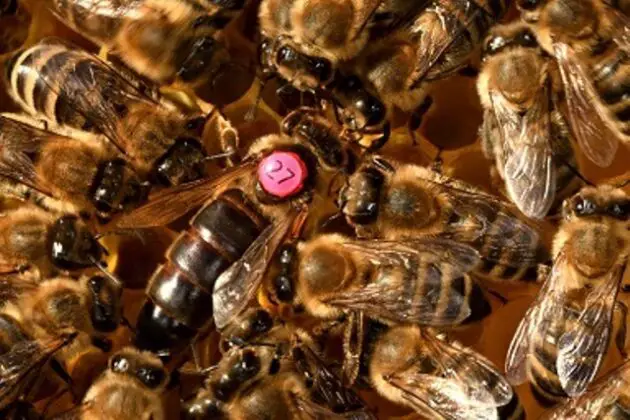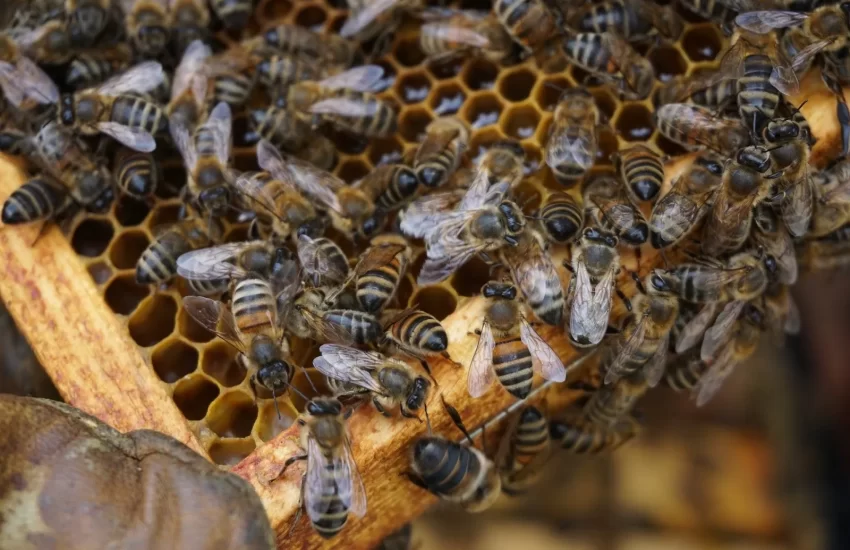How to Identify the Queen Bee
Up to 60,000 bees reside in a honey bee colony. Out of the massive population, a single queen bee resides, who is the soul of the nest. She is usually the mother of all or nearly all of the hive’s residents. To identify her from the masses can be an uphill task. Many struggles to find this beauty even after years in the venture.
Similar Articles you may like to read –
Are queen bees born or made?
How long do queen bees live?
How Many Times Does A Queen Bee Get Mated?
What Happens When a Queen Bee Dies?
How to requeen a beehive? When The Queen Dies
Her health and vitality determine the productivity of the hive. You don’t have to see her every time you conduct an inspection, but it is essential to know how to spot her with ease.
How a Queen Bee Comes to Be
All-female bees start from a fertilized egg. After two or three days, the destiny of the larvae is decided. The majority becomes worker bees since only one queen is needed in the colony. The larvae start with royal jelly ( 2-3 days) irrespective of the intended bee caste. Drone and worker bee larvae feed with bee bread after two days.
The Queen is fed with royal jelly after hatching until her death. It takes 16 days to develop into an adult. She develops in a particular cell known as a queen cell (peanut-shaped cell) that is larger than the other cells.
Apart from the one to a few days of her mating nuptials, she spends her entire life in the hive performing her significant role of egg-laying. She is fed and groomed by the worker bees.
How to Identify a Queen Bee
Here are ways of identifying the queen bee.
Size
You can single out her majesty, the queen, by her size. She is the largest in the nest. However, some drones can be equally big or bigger than her. In such a case, you can tell them apart by the breadth since the queen is narrower and longer.
Stinger
Queens have a barbless stinger. You can do this by holding them gently up by the thorax and inspecting the stinger with a magnifying glass. Its stinger is smooth, unlike the worker bees, which are barbed. Drones don’t have a stinger. Queens use their stingers to kill their rival queens.
Back
Her back is shiny, bald, and hairless. Others have fuzzy backs.
Abdomen
A bee’s abdomen is located on the lower part of its body. Unlike the other bees, which have blunt stomachs, the queen’s abdomen is pointed and lengthy. Her long abdomen extends beyond the end of her wings, making her seem like she has shorter wings.
Legs
Drones and worker bees position their legs directly under their bodies and are mostly invisible. The queen splays its legs outside, which makes them more visible. The legs are also long and shiny, unlike the other bees which have dark legs.
Work Station
The job of her majesty is to lay eggs. The brood nest is the location in the hive that contains the eggs, larvae, and capped brood. This is where she is most likely to be.
The Walking Style
A laying queen bee walks uniquely with her huge abdomen waggling across frames of honeycombs.
Queenly Behavior
The behavior of a queen and attendants around her( nurse worker bees) can help you identify her. Worker bees tend to be on the move constantly and work heavily for the colony’s success. On the contrary, the queen can overstay in one place. When she does, a group of worker bees surrounds her. When she moves, they clear the path for her.
The practice of identifying the queen bee gets better with time.
Do You Need to See the Queen in Every Inspection?
Thankfully, you don’t need to identify the queen during every inspection. There are signs of a laying queen you can single out to assure you she is alright. These include
Freshly laid eggs
A single egg in every cell glued at the bottom is a good measuring standard. It shows you that the queen was there within the last three days.
New patterns of young bee broad
A healthy brood pattern shows you that the queen is healthy and productive. Inspecting brood frames should be done regularly during colony inspections.
Should you Mark the Queen?
A marked queen is easier to locate. However, you have to pay extra money for her. Alternatively, you can mark her yourself. Eventually, you will still have an unmarked one because the colony can requeen without your consent.
How to Mark the Queen
You can consider marking the queen bee for easier identification. This involves putting a small dot of paint on her thorax (between her front legs). It is good to study her behavior, size, and shape even as you mark her.
The marking colors on your queen should represent the year of birth. A sequence of five different colors is used. This information helps you keep track of your queen’s age and prepare to requeen the colony as she ages. Here are the color codes apiarists use.
- White: For years ending in 1 or 6
- Yellow: For years ending in 2 or 7
- Red: For years ending in 3 and 8
- Green: For years ending in 4 and 9
- Blue: For years ending in 5 and 0
What is the difference between the Queen and Worker Bees?
A queen bee and worker bee originate from fertilized eggs. The only difference is the diet fed to them after two days. Every worker bee has the potential of becoming a queen if fed with royal jelly. These two bee castes have the same genes; a worker bee can lay eggs. This happens when there are low levels of queen pheromones in the colony. The Queen pheromones suppress the functioning of other female bees’ ovaries.
What happens when a queen dies?
When a queen bee dies, nurse bees select 10 -20 freshly hatched female larvae and start feeding them with the queen’s diet( royal jelly). The number of queens boosts the odds of producing a healthy new queen. This exclusive diet causes complete development of the larvae reproductive system turning them into potential queens.
The first queen to emerge kills all the other queens in the queen cells and remains alone. If two queens emerge simultaneously, they fight fiercely until one dies. The winning queen then takes mating flights to equip herself with enough sperms for the next 2- 3 years. The sperm reserve allows him to lay millions of eggs in her lifetime. In the peak seasons( summer and spring), she can lay up to 2000 eggs in a day. As she gets old, her egg-laying capacity decreases. The colony may begin another process of rearing another queen.
Eliminating an Old queen
An old queen will lay eggs until the end of her life. Meanwhile, the worker bees start the process of replacing the old champion. When the new queen is ready to start her duty, she locates the old queen and stings her to death. A colony can only be ruled by one queen at a time.
What Happens When a colony fails in rearing a new Queen
Sometimes, a colony may not succeed in raising a new queen bee. Unfortunately, such a colony cant survive for long. Due to the absence of the queen’s pheromones, the worker bees will continue to lay eggs. These are unfertilized eggs and result in drones. Drones don’t help to gather food resources; hence, the hive’s productivity drops drastically. The colony becomes stressed, worker bees become agitated and aggressive and prone to pests and diseases. A beekeeper can save such a bee colony by introducing a new queen.
Queen Bee Rejection
In some cases, a honey bee can reject a queen. This scenario happens when the older worker bees are not familiar with the new queen and her pheromones. They will see her as an invader and treat her aggressively. In most cases, it results when a beekeeper replaces a queen other than the colony by making their queen.
You can eliminate this challenge by introducing a new queen in a cage. Slowly, the colony becomes familiar with her and accepts the new queen. However, this method does not always work. If a queen is rejected, she will eventually die. Workers who see the queen as an invader will form a tight ball around her and sting her until she dies.
How Colonies Become Queenless
Death
The queen may be diseased, old, and slowly die.
Swarming
When swarming occurs, the queen leaves the hive with about half of the total worker bees and a few drones to start a new colony. This is how bee colonies multiply in the wild. Swarming happens due to overpopulation in the hive. The colony raises potential queens and the swarm leave before they emerge.
Disappearance
The queen may disappear, get lost, or be killed.
When a colony becomes queenless, the workers usually have a short period to create a new queen. If it fails, the colony slowly dies off. Fortunately, a beekeeper steps into such a situation by introducing a new queen. If the colony doesn’t reject her, it becomes productive again.
How to Introduce a New Queen to Prevent Rejection
To minimize the chances of the queen bee being assassinated, a beekeeper should introduce her into the colony with a cage. The cage protects her from aggressive worker bees. As she stays they may soon get used to her smell and presence. A cage with a candy plug works superbly. It takes the worker bees 2 to 5 days to eat the candy and reach her. By this time, they will have gotten familiar with her.
How Do You Tell a Queenless Colony
You know a colony without a functioning queen by lack of brood and eggs. The younger worker bees performing the house tasks like feeding the brood will start going to the field to forage; hence you will notice an increase in honey and pollen production. Another indicator is an increase in drones; the workers start laying unfertilized eggs, which results in drone bees.
Queen Rearing
Beekeepers can also raise new queens from young fertilized larvae. They do so to replace old queens, split hives, improve production or even sell queens to other beekeepers. The methods of raising vary among beekeepers. Some of the traits that are desirable to get a queen stock include
- Overwintering ability
- High honey production
- Disease and pest resistance
- Calm temperament
Most beekeepers opt to purchase new queens from well-established producers.
More articles you may like to read –
What Is A Queen Cup? How to grow a queen bee?
Can bees survive without sugar water?
Can you mix bee breeds?
Can a hive live without a queen? How can you tell a Queenless hive?
FAQs
How does a bee become a queen bee?
A queen originates from a fertilized egg. If she is destined to be a queen, she is fed with royal jelly throughout her life.
Which is the easiest way to find the queen?
If she is marked, it will be easy to spot her. If unmarked, you can look for her smooth stinger, splayed legs, shiny back or her long and pointed abdomen.
Can a queen bee sting you?
The queen’s stinger is to defend herself against the queen’s rivals. She never leaves the hive under normal circumstances. However, she is capable of stinging you multiple times because she has a smooth stinger.
What happens if a queen bee dies?
The worker bee starts the process of raising a new queen if she leaves fertilized eggs. They raise a new queen from a fertilized larva by feeding her with royal jelly.
What is the lifespan of a queen bee?
A queen bee lives for 2 to 3 years. But some can live up to 5 years.
Why do queen bees get rejected?
A queen may be rejected in a colony if the workers perceive she is an intruder. It mostly happens when an apiarist introduces a new queen.
Do queen bees eat their mates?
Queens don’t eat their mates. Instead, their mates die immediately after copulation as their sexual organs are ripped from them.
Can a queen bee fly?
A queen bee can fly. However, they are poor fliers due to their heavyweight and size. If a colony is planning to swarm, the workers will starve her for some days so that she can lose weight.
Can a queen bee survive solely?
A queen bee cannot survive independently since she depends on the young worker bees to feed her. She feeds on royal jelly secreted in special glands on the worker’s head.
Does the queen bee leave the hive?
A queen bee leaves the hive once to mate with drones in the drone assembly areas. He can also leave with a swarm.
Are there king bees?
There are no king bees. Male bees are usually referred to as drones.



